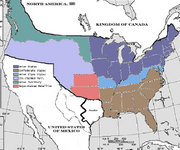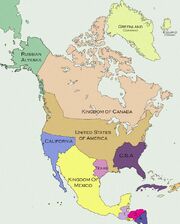| The Mexican-American War |
| The War of Secession |
| The Spanish-Americas War |
| The Great War |
| The Texan-American War |
| The World War |
| The Cold War |
| The Spasm |
| Post-Apocalypse Brush Wars |
The American Civil War (1861–1864) was a major war between the United States of America,(the "Union") and ten Southern slave states that declared their secession and formed the Confederate States of America, led by President Jefferson Davis. The Union, led by President Abraham Lincoln and the Republican Party, opposed the expansion of slavery and rejected any right of secession. Fighting commenced on April 12, 1861, when Confederate forces attacked a federal military installation at Fort Sumter in South Carolina. Known in the United States of America as the War of Secession and in the former Confederate States of America as the War of Northern Aggression this was the first of a series of bloody wars that rocked North America.
Causes[]
A growing sense of Abolitionism, shown in creation of the "Free soil" movement and later political party as well as concerns for slavery in the Northwest contributed to the unease in the region. The Sequoyo-Kansan Rebellion where the Native Americans of Sequoyah and the Kansans repudiated their status as slave states, appealing to the Compromise of 1850 and their right to "self-determination." This coupled with a sense of "states-rights" lead to the breakdon and eventual debacle.
Major Battles[]

Historians cite the major turning points in favor of the CSA as being the Disruption of the Union Blockade, Battle of Gettysburg and the Battle of Vicksburg.
Disruption of the Union Blockade[]
The CSA was recognized by Great Britain in June 1862 as a sovereign nation, still wounded by the loss of the Oregon Country, and along with France sent ships to aid the Confederates. This act spurred a continued hatred by the USA against Britain, a hatred that would be revenged in later wars.
Battle of Gettysburg[]
In the Battle of Gettysburg, Pickett's charge of Cemetery Hill routed the Northerners, paving the way for a string of victories that greatly strengthened the Southern position for a time. They were eventually pushed back, and Virginia and Kentucky were divided between the two nations.
Battle of Vicksburg[]
The Battle of Vicksburg was supported by Texan mercenaries, which lead to the defeat of Union forces. Had they succeeded, supply lines to the CSA would've been severed. With this victory, southern forces were able to rally against the "Aggressors."

Map showing CSA and USA boundaries following the War of Secession.
By the time of elections in 1864, public opinion had turned against Abraham Lincoln, and George B. McClellan was elected president. Shortly thereafter a peace was arranged and borders with the South were fixed as shown in the map at right.
War in the West[]
Before a peace treaty was negotiated General George Henry Thomas successfully captured Missouri, Arkansas, and Louisiana, opening trade along the Mississippi.
Aftermath[]
With the North subdued, Texas instigated a war in 1870 between California and the Kingdom of Mexico. As the war continued, Texan mercenaries with support from the CSA invaded Mexico, securing Albuquerque, Santa Fe, all the way to the coast near the mouth of the Colorado River. With this land secured, and a buffer created for California, a peace-treaty and non-aggression pact were signed. Mexico chafed with the loss of this territory, but as it was mostly desert, the loss did not completely destabilize the nation.
